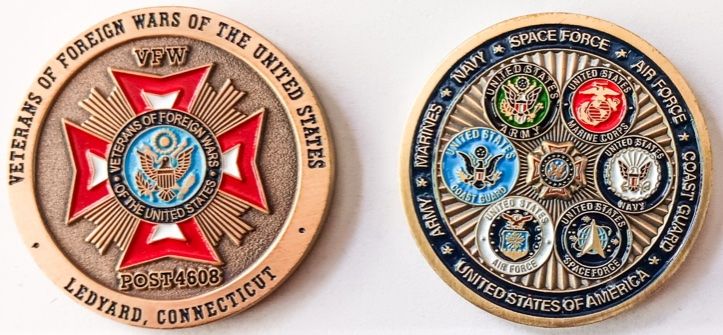Oct. 8, 2017 | by Katie Lange, DOD News
The coins represent anything from a small unit to the offices of top leaders, such as the Defense Secretary. There are also coins made for special events, anniversaries and even nonmilitary leaders.
Many service members and veterans proudly display challenge coins at their desks or homes, showing off the many missions they've been on, the top leaders they've met and the units for which they've worked.

But how did this tradition get started?
The Most Common Assumption
The most well-known story that the internet produced linked the challenge coin tradition back to World War I. As the U.S. started building up its Army Air Service, many men volunteered to serve. One of those men was a wealthy lieutenant who wanted to give each member of his unit a memento, so he ordered several coin-sized bronze medallions to be made.
The lieutenant put his own medallion in a small leather pouch that he wore around his neck. A short time later, his plane was shot down over Germany. He survived, but was captured by a German patrol, who took all of his identifiable items so he would have no way to identify himself if he escaped. What they didn't take was the small pouch with the medallion.
The lieutenant was taken to a small town near the front lines of the war. Despite his lack of ID, he managed to find some civilian clothing and escaped anyway, eventually stumbling into a French outpost. Wary of anyone not in uniform, the French soldiers didn't recognize his accent and immediately assumed he was an enemy.
They initially planned to execute him, since they couldn't ID him. But the lieutenant, remembering he still had the small pouch around his neck, pulled out the coin to show the soldiers his unit's insignia. One of the Frenchmen recognized that insignia, so he was spared.
Instead of being executed, the lieutenant was given a bottle of wine, probably as a form of reparation for his initial treatment. The he finally made it back to his squadron, it became a tradition for all service members to carry a unit-emblazoned coin at all times, just in case.
Not Everyone Believe That Depiction
While that story sounds cool, Air Force Historical Research Agency archivist Barry Spink isn't buying it. He said he'd been told in the 1990's that the tradition started in Vietnam, when an Army infantry-run bar tried to keep non-infantrymen away by forcing "outsiders" to buy drinks for the whole bar if they couldn't prove they had been in combat. The "proof" started with enemy bullets, then got a little out of control with grenades, rockets and unexploded ordnance. So a coin-sized item emblazoned with the unit's insignia became the accepted form of proof.
This tradition -- now known as a coin check -- continues today, hence it being called a "challenge" coin.
One More Possibility
Spink also sent me an article called "Coining a Tradition" that was printed in a 1994 edition of Soldiers Magazine. It offered a similar version of the Vietnam story, the World War I tale and one other option, which dates back to the early 1960's:
"A member of the 11th Special Forces Group (SFG) took old coins, had them overstepped with a different emblem, then presented them to unit members, according to Roxanne Merritt, curator of the John F. Kennedy Special Warfare Museum at Fort Bragg, N.C. A former commander of the 10th SFG picked up on the idea, becoming the first to mint a unit coin for the U.S. military unit. The 10th group remained the only Army unit with its own coin until the mid-1980's, Merritt said, when 'an explosion took place and everybody started minting coins.'"
So if you've ever wondered how the challenge coin came about, you can take your pick of which story to believe!
